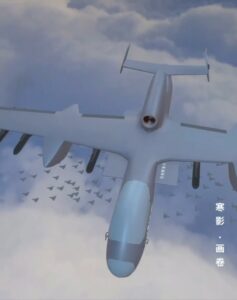China is preparing to test its next-generation unmanned aerial system, the Jiutian SS-UAV, a massive high-altitude “mothership” designed to deploy swarms of attack drones and precision-guided missiles. This unmanned behemoth could redefine aerial warfare, blending long-range reconnaissance with strike capabilities in a single platform.
The Jiutian SS-UAV boasts staggering performance metrics:
-
Range: 7,000–7,500 km (comparable to strategic bombers)
-
Service ceiling: 15 km (bypassing most air defenses)
-
Payload capacity: Two launch modules housing hundreds of FPV kamikaze drones (25–35 km range)
-
Heavy ordnance: Anti-ship missiles, stealth cruise missiles, and aeroballistic weapons
-
Air-to-air self-defense: PL-12E/PL-15 missiles to engage enemy fighters
-
AI coordination: Autonomous swarm control for mass drone attacks
Reportedly weighing 15 tons with a 25-meter wingspan, the Jiutian matches the Global Hawk’s size but adds a devastating offensive punch, making it a dual-role recon-strike platform.
A Drone Swarm Revolution
The Jiutian’s most disruptive feature is its ability to deploy over 100 loitering munitions (akin to Russia’s Geran-2) in a single sortie. These drones, guided by AI, could overwhelm air defenses, strike high-value targets, or conduct electronic warfare, all while the mothership remains safely at altitude.
By merging long-range strike, drone swarm warfare, and standoff missile attacks, China is creating a system with no direct equivalent in modern arsenals.
Challenging U.S. Air Dominance
The Jiutian’s 7,000+ km range allows it to operate deep in the Pacific, threatening U.S. bases, carrier groups, or allied territories. Its high-altitude endurance complicates interception, while its swarm tactics could saturate even advanced defenses like Patriot.
Notably, the drone carrier’s air-to-air missiles suggest China anticipates contested airspace, a direct challenge to U.S. and allied air superiority. Analysts warn it could shift the balance in scenarios like a Taiwan contingency, where mass drone attacks might precede larger assaults.
The Jiutian’s first test flight is expected in June 2025. The U.S. has yet to field a comparable system, though projects like DARPA’s Gremlins (recoverable drone swarms) hint at similar directions.
The Jiutian is expected to “spook the U.S.,” emphasizing its potential to outmaneuver traditional air defenses. If successful, China will have pioneered a new paradigm: aerial warfare dominated by AI-coordinated swarms launched from stealthy, high-altitude carriers.
The Future of Warfare Takes Flight
The Jiutian SS-UAV isn’t just another drone—it’s a floating airbase that merges reconnaissance, electronic warfare, and strike missions into a single platform. By leveraging swarm autonomy and long-range precision weapons, China is betting on asymmetric saturation tactics to counter superior fighter fleets and missile defenses. When the Jiutian takes to the skies in June, the world will witness a glimpse of next-gen warfare, where the sky itself becomes a battlespace ruled by drone armies. For the U.S. and its allies, the race to counter this technology starts now.





lol!! come on, shake it baby, shake it! it’s party time, mosquito party!
i hope russia will buy some of these aircraft as soon as they are put up for sale. they would certainly be a big advantage for their forces. you will see the ukr fkr hellensky do a dance then!
unless its stealth, i think it would be a much easier target to shoot down than the swarm of drones themselves
range is protection . quantity has a quality all its own . stealth is obsolete and has been for years .
the mother-ship will deploy outside of strike range, high above the skies. or under the protection of air defense.
now, you can throw another two cents worth and tell us what general electric has that’s better.
which particular nato air defense system did you have in mind? the ‘thaad’ may be able to hit something at 45,000 feet, but it can only hit ballistic missiles – and then only sometimes. anything that does not fly on a predictable course is immune to it. and the aa missiles this thing uses have already been proven by pakistan to shoot down 6th generation nato fighters.
another example of that “nuclear weapon” do not exist. you have be fouled by clowns, german from the beginning. it looks like “multipolar world” means get rid of the jews, a usual white project. no action from russia = no moral there either.
the fighter jet is obsolete . the aircraft carrier is obsolete . the us military is obsolete . but will demand budget increase from new threat . but , china can produce these deals in such masses the the us could never equal . us military banker mafia is a looser .
looks like russia lose again on innovation. tbe chinese are superior in all respects.
they are allies.
as we are led to believe
the chinese, like the russians, have very long memories. just as the russians will never forget the usa companies that brought hitler to power (esso, ford, ibm, itt, gm, bbh bank), the chinese will never forget that in 1945 the russians defeated the million man japanese kwantung army, in one week – including the notorious unit 731 biological warfare unit that the usa subsequently used to establish their own biological warfare program at fort detrick.